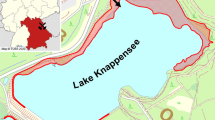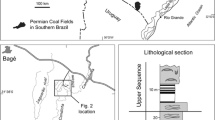Abstract
The unique case of carbon dioxide accumulation in the bottom layer of the acidic lake formed in the Guadiana open pit (Herrerías mine, SW Spain) led to exceptionally high dissolved gas pressures (ca. 5.0 bar at depths of 50–70 m). This CO2 has formed by carbonate (calcite, dolomite) dissolution during decades of interaction of the acidic water with the rocks of the pit walls and associated mine tunnels. The elevated dissolved gas pressures were only comparable to those found in the volcanic crater lakes of Cameroon like Nyos and Monoun, which erupted in the 1980s and sadly triggered the loss of hundreds of human lives. This gas pressure was not far from the absolute (hydrostatic plus atmospheric) pressure limiting CO2 solubility at depth, thus making this pit lake potentially dangerous for the possibility of a hypothetical limnic eruption. Following detailed field and experimental studies aimed at deciphering the source and accumulation patterns of CO2 in the lake, a degassing project started in 2014, which followed an upscaling strategy with construction and installation of progressively bigger pipelines capable of extracting increasingly higher flow rates of CO2-charged water from the deep part of the lake. As of May 2019, the degassing systems have successfully extracted most of the CO2 originally present in the lake (i.e. ≈ 123,000 m3 CO2), which has been discharged to the atmosphere in a controlled and safe way. The fountains became progressively smaller and finally stopped, due to the decreased gas pressure at depth. The larger pipes will serve as a regulating system in the future. This paper describes the main findings encountered during the degassing project, some relevant technical issues observed during the last 5 years (2014–2019), and lessons learnt from the Guadiana pit lake experience.
Zusammenfassung
Der einzigartige Fall einer Kohlendioxidanreicherung in der bodennahen Schicht eines sauren Sees wurde in dem Guadiana-Tagbau der Herrerias Mine gebildet, mit außergewöhnlich hohem Druck von gelöstem Gas (ca. 5 bar in 50-70 m Tiefe). Das CO2 entstand durch Lösung von Karbonaten (Kalzit, Dolomit) während einer Jahrzehnte langen Interaktion des sauren Wassers mit den Gesteinen der Tagbauböschung. Die erhöhten Drucke gelösten Gases waren nur mit jenen vergleichbar, welche in vulkanischen Kraterseen wie Nyos und Monoun (Kamerun) gefunden wurden. Diese brachen in den 1980er Jahren aus, wodurch Hunderte Menschenleben zu beklagen waren. Die Gasdrucke lagen nahe an der absoluten Grenze welche die Löslichkeit von CO2 in der Tiefe limitiert (hydrostatisch plus atmosphärisch). Der Tagbausee war damit eine Gefahr für eine limnische Eruption. Nach Untersuchungen im Felde und Experimenten, um die Gasquelle und die Anreicherungsbilder im See zu klären, wurde 2014 ein Entgasungsprojekt begonnen. Dabei wurde die Strategie einer Hochskalierung verwendet, indem zunehmend größere Rohre konstruiert und installiert wurden, so daß anwachsende Durchflußraten von CO2 gesättigtem Wasser aus der Tiefe des Sees resultierten. Bis Mai 2019 wurde der größte Teil des ursprünglich im See vorhandenen CO2 (ca. 123.000 m3) extrahiert und in die Atmosphäre entlassen. Infolge des abnehmenden Gasdrucks in der Tiefe wurden die Fontänen zunehmend kleiner bis sie versiegten. In der Zukunft werden die größeren Rohre der Regulierung dienen. Im Text beschreiben wir die wichtigsten Erfahrungen, technische Beobachtungen während der Jahre 2014-2019, und Lektionen aus dem Projekt.
Resumen
El caso único de la acumulación de dióxido de carbono en la capa inferior del lago ácido formado en la mina a cielo abierto de Guadiana (mina Herrerías, SW España) provocó presiones de gas disuelto excepcionalmente altas (aproximadamente 5,0 bar a profundidades de 50-70 m). Este CO2 se ha formado por disolución de carbonato (calcita, dolomita) durante décadas de interacción del agua ácida con las rocas de la corta minera y galerías asociadas. Las elevadas presiones de gas disuelto solo fueron comparables a las que se encuentran en los lagos de cráteres volcánicos de Camerún como Nyos y Monoun, que estallaron en la década de 1980 y desencadenaron la pérdida de cientos de vidas humanas. Esta presión de gas no estaba lejos de la presión absoluta (hidrostática más atmosférica) que limitaba la solubilidad del CO2 en profundidad, lo que hacía que este lago de pozo fuera potencialmente peligroso por la posibilidad de una hipotética erupción línica. Después de detallados estudios de campo y experimentales destinados a determinar la fuente y los patrones de acumulación de CO2 en el lago, en 2014 se comenzó un proyecto de desgasificación que siguió una estrategia de escalado progresivo con la construcción e instalación de tuberías progresivamente más grandes y capaces de extraer caudales cada vez más altos de agua cargada de CO2 de la parte profunda del lago. A partir de mayo de 2019, los sistemas de desgasificación han extraído con éxito la mayor parte del CO2 originalmente presente en el lago (es decir, ≈ 123000 m3 de CO2), que se ha descargado a la atmósfera de manera controlada y segura. Las fuentes se hicieron cada vez más pequeñas y finalmente se detuvieron, debido a la disminución de la presión del gas en profundidad. Las tuberías más grandes servirán como un sistema de regulación en el futuro. Este documento describe los principales hallazgos encontrados durante el proyecto de desgasificación, algunos problemas técnicos relevantes observados durante los últimos cinco años (2014-2019) y las lecciones aprendidas de la experiencia del lago Guadiana.
抽象
Guadiana露天矿坑(Herrerías mine, SW Spain)酸性矿坑湖底罕见的二氧化碳积聚形成了异常的溶解气体高压(在50-70米深处约5.0巴)。二氧化碳由露天坑壁岩石(方解石、白云石)碳酸盐与酸性湖水之间几十年的溶解反应生成。溶解气体压力升高的情形可与喀麦隆Nyos和Monoun火山口湖高压可溶气体情形类比,后者20世纪80年代爆发导致数百人不幸死亡。由于湖水深部溶解气体压力已经接近二氧化碳溶解度的绝对压力(流体静压加大气压力)界限值,湖水具有潜在灾害性喷发的可能。详尽的野外和室内试验旨在揭示二氧化碳产生根源和气体积聚方式。在2014年启动了湖水脱气项目之后,项目方案不断改进,建设和安装了越来越大的从湖底抽取饱含CO2水的管道系统。至2019年5月,脱气系统已成功地抽取出大部分湖水原有CO2(123,000 m3 CO2),以安全和可控的方式排放到大气中。由于湖水深处气体压力减小,泉水越变越小,甚至停止。更大的脱气管道将用作未来常规脱气。文章介绍了脱气项目运行期间的主要发现、过去五年(2014-2019年)遇到相关技术问题和Guadiana湖给我们的教训。












Similar content being viewed by others
References
Ansede M (2016) The danger hiding under Spain’s ‘killer lake’. El País, https://elpais.com/elpais/2016/07/25/inenglish/1469440871_222255.html
Boehrer B, Magin K, Yusta I, Sánchez-España J (2016) Quantifying, assessing and removing extreme gas load from meromictic Guadiana pit lake, southwest Spain. Sci Total Environ 563–564:468–477
Boehrer B, von Rohden C, Schultze M (2017) Physical features of meromictic lakes: Stratification and circulation. In: Gulati RD, Zadereev ES, Degermendzhi AG (eds) Ecology of meromictic lakes. Springer, Heidelberg, pp 15–34
Boehrer B, von Tümpling W, Mugisha A, Rogemont C, Umutoni A (2019) Reliable reference for the methane concentrations in Lake Kivu at the beginning of industrial exploitation. Hydrol Earth Syst Sc. https://doi.org/10.5194/hess-2019-228
Cui Y, Zhu G, Li H, Luo L, Cheng X, Jin Y, Trolle D (2016) Modeling the response of phytoplankton to reduced external nutrient load in a subtropical Chinese reservoir using DYRESM-CAEDYM. Lake Reserv Manag 32:146–157
Delgado J, Juncosa-Rivera R, Falcón-Suárez I, Canal-Vila J (2013) Four years of continuous monitoring of the Meirama end-pit lake and its impact in the definition of future uses. Environ Sci Pollut Res Int 20(11):7520–7533
Geller W, Schultze M, Wisotzky F (2013) Remediation and management of acidified pit lakes and outflowing waters. In: Geller W, Schultze M, Kleinmann R, Wolkersdorfer C (eds) Acidic pit lakes. Springer, Heidelberg, pp 225–264
Halbwachs M, Sabroux JC, Granjeon J, Kayser G, Tochon-Danguy JC, Felix A, Beard JC, Villevieille A, Vitter G, Richon B, Wuest A, Hell J (2004) Degassing the “killer lakes” Nyos and Monoun. Cameroon. EOS 85(30):281–288
Horn C, Metzler P, Ullrich K, Koschorreck M, Boehrer B (2017) Methane storage and ebullition in monimolimnetic waters of polluted mine pit lake Vollert-Sued, Germany. Sci Total Environ 584–585:1–10
Kling GW, Evans WC, Tuttle MI, Tanyleke G (1994) Degassing of Lake Nyos. Nature 368:405–406
Kling GW, Evans WC, Tanyleke G, Kusakabe M, Ohha T, Yoshida Y, Hell JV (2005) Degassing lakes Nyos and Monoun: defusing certain disaster. Proc Nat Ac Sci 102:14185–14190
López-Pamo E, Sánchez-España J, Diez M, Santofimia E, Reyes A (2009) Cortas mineras inundadas de la Faja Pirítica: Inventario e hidroquímica. Serie Medio Ambiente, Nº 13, Publicaciones del Instituto Geológico y Minero de España, Ministerio de Ciencia e Innovación, Madrid
López-Pamo E, Sánchez-España J, Santofimia E, Reyes J, Martín-Rubí JA (2010) Limnología físico-química del lago formado durante la inundación de la Corta de Reocín, Cantabria (Marzo 2009–Febrero 2010). Instituto Geológico y Minero de España (IGME), Ministerio de Ciencia e Innovación, Unpubl Report, Madrid
Murphy WM (1997) Are pit lakes susceptible to limnic eruptions? Proceedings, tailings and Mine Waste 97. Balkema, Rotterdam, pp 545–547
Nordstrom DK, Alpers C (1999) Geochemistry of acid mine waters. Rev Econ Geol, vol. 6A, The environmental geochemistry of mineral deposits, part A: processes, techniques, and health issues, 133–160
Pinedo Vara I (1963) Piritas de Huelva. Su historia, minería y aprovechamiento. Ed Summa, Madrid
Sánchez-España J, López-Pamo E, Santofimia E, Diez-Ercilla M (2008) The acidic mine pit lakes of the Iberian pyrite belt: an approach to their physical limnology and hydrogeochemistry. Appl Geochem 23:1260–1287
Sánchez-España J, Diez M, Santofimia E (2013) Mine pit lakes of the Iberian pyrite belt: some basic limnological, hydrogeochemical and microbiological considerations. In: Geller W, Schultze M, Kleinmann B, Wolkersdorfer C (eds) Acidic pit lakes: the legacy of coal and metal surface mines. Springer, Heidelberg, pp 315–342
Sánchez-España J, Boehrer B, Yusta I (2014) Extreme carbon dioxide concentrations in acidic pit lakes provoked by water/rock interaction. Env Sci Technol 48:4273–4281
Sánchez-España J, Yusta I, Gray J, Burgos WD (2016) Geochemistry of dissolved aluminium at low pH: extent and significance of Fe–Al coprecipitation below pH 4.0. Geochim Cosmochim Acta 175:128–149
Sánchez-España J, Yusta I, Suárez J (2018) Communicating geochemical threats to local and regional authorities: the Guadiana pit lake experience. Goldschmidt Conf Abstr, Boston
Santofimia E, López-Pamo E, Sánchez-España J, Schultze M, Friese K (2007) Hydrogeochemical evolution of the Aznalcollar pit lake during the spill of a pyrite pile. In: Cidu R, Frau F (eds) Proceedings International Mine Water Assoc Conf, Cagliari, Italy, pp 453–457
Schultze M, Friese K, Sánchez-España J, López E (2006) Pit lake Aznalcóllar—water chemistry and options of control. In: Barnisel RI (ed) Proceedings of the 7th international conference on acid rock drainage (ICARD), ASMR, Lexington, USA, pp 1927–1935
Schultze M, Boehrer B, Wendt-Potthoff K, Sánchez-España J, Castendyk D (2017) Meromictic pit lakes: case studies from Spain, Germany and Canada and general aspects of management and modelling. In: Gulati RD, Zadereev AE, Degermendzhi AG (eds) Ecology of Meromictic Lakes, ecological studies 228. Springer, Cham, pp 235–275
Tanyileke G, Ntchantcho R, Yetoh Fantong W, Tongwa Aka F, Hell JV (2019) 30 years of the lakes Nyos and Monoun gas disasters: a scientific, technological, institutional and social adventure. J African Earth Sci 150:415–424
Torres E, Galván L, Cánovas CR, Soria-Píriz S, Arbat-Bofill M, Nardi A, Papaspyrou S, Ayora C (2016) Oxycline formation induced by Fe(II) oxidation in a water reservoir affected by acid mine drainage modeled using a 2D hydrodynamic and water quality model—CE-QUAL-W2. Sci Total Environ 562:1–12
Younger PL, Banwart SA, Hedin RS (2002) Mine water: hydrology, pollution, remediation. Kluver Academic Publishers, Dordrecht
Acknowledgements
The HERCO2 project has been funded by the Dirección General de Industria, Energía y Minas, Junta de Andalucía (General Division of Industry, Energy and Mines, Andalusian Regional Government) through contract number MEN/2017/0045. We thank Iván Maldonado and Ricardo Dieguez, mining engineers at the Bureau of Mines in Seville, for permission to access the mine and for their management in the context of the collaborative framework between IGME and Junta de Andalucía. We also thank Antonio Beltrán, Mayor of the Puebla de Guzmán Municipality, for his encouragement and help during the degassing operations and our colleagues from the IGME laboratories (Jesús Reyes, Ana Nieto, Mercedes Castillo, Maite Andrés) for the chemical analyses of water samples. Our most special gratitude goes to Mr. José Suárez, former mining engineer in the Bureau of Mines, Professor at the University of Huelva, and President of Asociación Herrerías (a non-profit foundation devoted to the preservation and dissemination of Herrerías historical mining heritage) for his tireless and continuous support. Finally, we thank Dmitri Rouwet and an anonymous reviewer for their comments on an earlier version of this manuscript, and the editors of this journal for their editorial comments and suggestions.
Author information
Authors and Affiliations
Corresponding author
Rights and permissions
About this article
Cite this article
Sánchez-España, J., Yusta, I. & Boehrer, B. Degassing Pit Lakes: Technical Issues and Lessons Learnt from the HERCO2 Project in the Guadiana Open Pit (Herrerías Mine, SW Spain). Mine Water Environ 39, 517–534 (2020). https://doi.org/10.1007/s10230-020-00654-1
Received:
Accepted:
Published:
Issue Date:
DOI: https://doi.org/10.1007/s10230-020-00654-1




